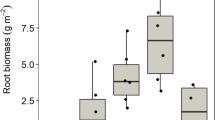Abstract
We investigated the hypothesis that hemiparasites accelerate nutrient cycling in nutrient-poor communities. Hemiparasites concentrate nutrients in their leaves, thus potentially producing high quality litter that releases nutrients that would otherwise remain in host tissues or in slowly decomposing plant litter. This hypothesis was tested using species from a European sub-arctic community where root hemiparasites are abundant. The N content of green leaves, and the N, P and C content of leaf litter were measured in seven species of root hemiparasitic Scrophulariaceae, and nine species of commonly co-occurring dwarf shrubs, graminoids and herbs. Fresh leaves of the hemiparasites had greater N concentrations than leaves of dwarf shrubs, graminoids or herbs. This difference was even more marked in litter, with hemiparasite litter containing 1.8–4.1% N, between 1.8 and 8.5 times as much N as in the litter of commonly co-occurring species. Litter of the hemiparasitic plant Bartsia alpina and of three commonly co-occurring dominant species of dwarf shrub was decomposed alone and in two species mixtures, in a laboratory microcosm experiment. Bartsia litter decomposed faster and lost between 5.4 and 10.8 times more N than that of the dwarf shrubs over the 240 days of the experiment. Mixtures of dwarf shrub and hemiparasite litter showed significantly more mass loss and CO2 release than expected, while nutrient release was the same as or less than expected. It is concluded that hemiparasites have the potential to enhance decomposition and nutrient cycling in nutrient-poor environments.
Similar content being viewed by others
Author information
Authors and Affiliations
Additional information
Electronic Publication
Rights and permissions
About this article
Cite this article
Quested, H.M., Press, M.C., Callaghan, T.V. et al. The hemiparasitic angiosperm Bartsia alpina has the potential to accelerate decomposition in sub-arctic communities. Oecologia 130, 88–95 (2002). https://doi.org/10.1007/s004420100780
Received:
Accepted:
Published:
Issue Date:
DOI: https://doi.org/10.1007/s004420100780




